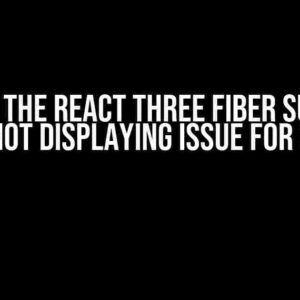Are you tired of struggling to run your React app with WAMP? Do you want to learn the secret to making it work seamlessly? Look no further! In this comprehensive guide, we’ll take you by the hand and walk you through the process of running a React app with WAMP using ports 5173 and 3000. By the end of this article, you’ll be a master of React-WAMP integration.
Why Do We Need to Use WAMP with React?
Before we dive into the nitty-gritty, let’s talk about why we need to use WAMP with React in the first place. WAMP (Windows, Apache, MySQL, and PHP) is a popular web development stack that allows us to create dynamic web applications with ease. However, when it comes to React, we need a way to serve our application to the world. This is where WAMP comes in – it provides a robust and reliable environment for our React app to thrive.
The Problem: Running React with WAMP
The problem arises when we try to run our React app with WAMP. By default, React uses port 3000, while WAMP occupies port 80. This creates a conflict, and our React app refuses to work as expected. That’s where ports 5173 and 3000 come into play. We’ll use port 5173 to run our React app and port 3000 to proxy requests to WAMP.
Step 1: Install and Configure WAMP
Before we begin, make sure you have WAMP installed on your system. If you haven’t, download and install it from the official website. Once installed, follow these steps to configure WAMP:
- Open the WAMP manager and start the WAMP server.
- Open your web browser and navigate to
localhost, and you should see the WAMP homepage. - Create a new folder in the
C:\wamp64\wwwdirectory (or the equivalent for your WAMP installation) and name itreact-app. - Move your React app files to the
react-appfolder.
Step 2: Configure Your React App
Now, let’s configure our React app to work with WAMP. Open your React app’s package.json file and add the following script:
"scripts": {
"start": "PORT=5173 react-scripts start",
"build": "react-scripts build",
"test": "react-scripts test"
}
This script tells React to use port 5173 instead of the default port 3000.
Step 3: Create a Proxy Server
To proxy requests from our React app to WAMP, we’ll create a proxy server using the http-proxy-middleware package. Run the following command in your terminal:
npm install http-proxy-middleware
Next, create a new file called setupProxy.js in the root of your React app and add the following code:
const { createProxyMiddleware } = require('http-proxy-middleware');
module.exports = function(app) {
app.use(
'/api',
createProxyMiddleware({
target: 'http://localhost:80',
changeOrigin: true,
})
);
};
This code sets up a proxy server that forwards requests from /api to http://localhost:80, which is where WAMP is running.
Step 4: Run Your React App with WAMP
Now it’s time to run your React app with WAMP. Open two separate terminal windows and run the following commands:
// Terminal 1 npm start // Terminal 2 wamp64.exe
The first command starts your React app on port 5173, while the second command starts the WAMP server on port 80.
Step 5: Test Your React App with WAMP
Open your web browser and navigate to http://localhost:5173. You should see your React app running smoothly. Now, try making a request to http://localhost:5173/api (or any API endpoint you’ve set up). The request should be proxied to WAMP, and you should see the expected response.
Troubleshooting Common Issues
If you encounter any issues while running your React app with WAMP, refer to the following table for troubleshooting tips:
| Error Message | Solution |
|---|---|
| React app not starting on port 5173 | Check that you’ve updated the package.json file and restarted your React app. |
| Proxy server not working | Verify that you’ve created the setupProxy.js file and updated the proxy configuration. |
| WAMP not starting on port 80 | Check that you’ve started the WAMP server and that port 80 is not occupied by another process. |
Conclusion
And that’s it! You’ve successfully run your React app with WAMP using ports 5173 and 3000. This configuration allows you to take advantage of WAMP’s robust features while still enjoying the benefits of a React app. Remember to follow the troubleshooting tips if you encounter any issues. Happy coding!
Additional Tips:
- Make sure to update your React app’s
package.jsonfile to reflect the new port number (5173). - If you’re using a virtual host in WAMP, update the
httpd.conffile to include the new port number. - For production environments, consider using a more robust proxy server like NGINX or Apache.
By following this comprehensive guide, you’ve taken the first step in mastering the art of running React apps with WAMP. Happy coding, and don’t hesitate to reach out if you have any questions or need further assistance!
Here are the 5 Questions and Answers about “How to run a React app with WAMP with ports 5173 and 3000”:
Frequently Asked Question
Are you struggling to run your React app with WAMP using ports 5173 and 3000? Look no further! We’ve got you covered with these frequently asked questions and answers.
Q1: Why do I need to use ports 5173 and 3000 to run my React app with WAMP?
Port 5173 is the default port used by VITE, a development server that comes with Create React App, while port 3000 is the default port used by the React development server. Using both ports allows you to run your React app and WAMP simultaneously, making it easier to develop and test your application.
Q2: How do I configure WAMP to use port 5173?
To configure WAMP to use port 5173, you need to create a virtual host in your WAMP server. Create a new file in the `C:\wamp\bin\apache\apache2.4.9\conf\extra` directory (assuming you’re using WAMP 3.1.3) and add the following code: `
Q3: How do I run my React app on port 3000?
To run your React app on port 3000, navigate to your project directory and run the command `npm start` or `yarn start`. This will start the React development server, which will be accessible at `http://localhost:3000`. Make sure you have the correct script in your `package.json` file, e.g., `”start”: “react-scripts start”`.
Q4: How do I access my React app on port 3000 while WAMP is running on port 5173?
You can access your React app on port 3000 by visiting `http://localhost:3000` in your web browser. Since WAMP is running on port 5173, you can still access your WAMP server by visiting `http://localhost:5173`. You can now switch between your React app and WAMP server by changing the port number in your browser’s URL bar.
Q5: Are there any security concerns when running multiple servers on different ports?
Yes, there are security concerns when running multiple servers on different ports. Make sure you’re only allowing access to the necessary ports and IP addresses. Also, ensure that your React app and WAMP server are configured to use secure protocols (e.g., HTTPS) and follow best practices for security and authentication. Never expose your development server to the public internet without proper security measures in place.
I hope these FAQs help you run your React app with WAMP using ports 5173 and 3000!






